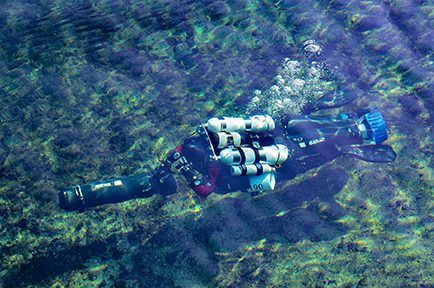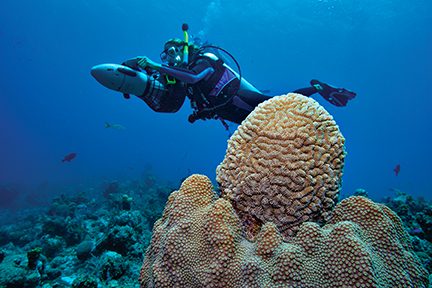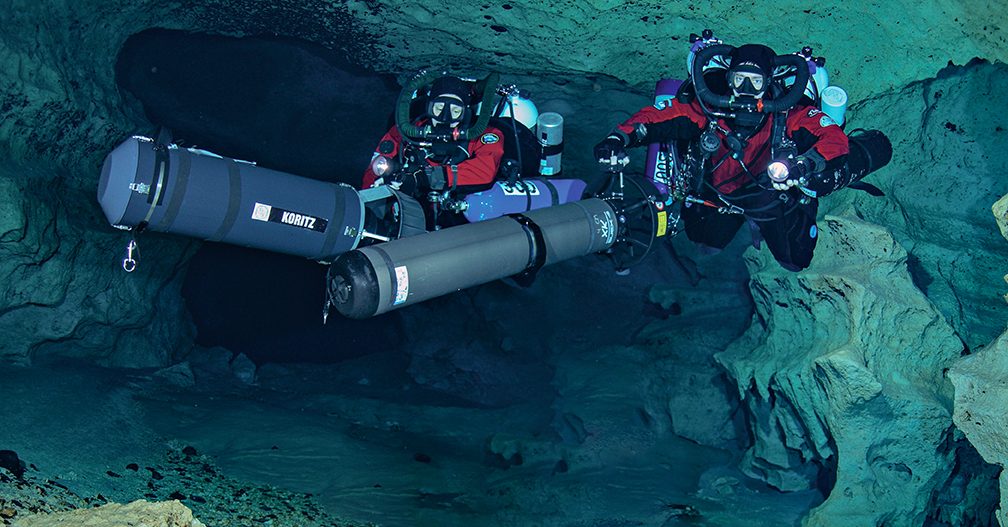NEW AND IMPROVED TECHNOLOGY enters the dive industry every year. Advancements can make diving safer, more enjoyable, or sometimes both.
The Italian navy deployed the first known practical diver propulsion vehicle (DPV) during their World War II military operations. DPVs eventually became available for use by recreational divers worldwide. Early DPVs were big, heavy, loud, and had short battery life. As the technology progressed, however, so did their design and features.
Divers of all experience levels can now utilize smaller, lighter, faster, quieter, and more reliable DPVs to make their diving safer and more enjoyable.

Types of DPVs
Several styles of DPVs are currently on the market, but divers most commonly use three of them.
The first type is a small, handheld DPV for confined water or shallow open-water dives. They have a low power output and do not have a long battery run time. These DPVs are solely for recreational purposes due to these limitations.
The second style is a larger DPV that divers can grip with two hands or sit astride and move through the water hands-free. The battery run time is sufficient for slightly longer dives, but these DPVs are also solely for recreational purposes on shallow open-water dives.
The third style is more common for advanced recreational or technical divers or those undertaking exploration efforts. These DPVs are large, powerful, and reliable. The diver attaches to them with a crotch strap D-ring and steers them with one or two hands as it tows them through the water.
Common Applications
Divers can use DPVs in a range of environments and for various goals. The average recreational diver might use them to conserve their energy while traveling around a dive site, while DPVs might help a technical diver combat heavy flow or current, extend their penetration distance into an overhead environment, or cover ground more efficiently on the bottom phase of the dive to have shorter dive times and reduced decompression obligations.
During exploration efforts, divers can use survey technology in conjunction with a DPV to collect data points for constructing maps and other educational materials. Each diver in a team might use multiple DPVs to expand the exploration boundaries beyond what was previously thought possible.


Considerations Before Purchasing
DPVs are expensive, and any diver considering purchasing one should do thorough research. Reading product reviews, speaking with gear manufacturers, and listening to advice and personal experiences from friends and mentors can help with assessing a DPV.
Intended use: As previously discussed, DPVs have several uses, so divers should evaluate what they intend to do with it before purchasing one. It is also worth considering future goals and how the DPV can grow with a diver as they expand their skillset.
Battery type, power, and run time: Most modern DPVs contain large batteries that commercial airlines won’t transport. Buying one with removable, airline-compliant batteries is necessary if a diver prefers to fly with a DPV. Regardless of the style, one with lithium-ion batteries will offer good reliability and longer run times than other options. Evaluating the battery power and run time will help ensure that the DPV can assist a diver in achieving all the intended goals of their current and future dives.
Customer support accessibility: Purchasing dive equipment from a local dive shop is always recommended, and a DPV is no exception. Having a qualified service technician readily available is helpful since DPVs require regular maintenance and are cumbersome and costly to ship.
Cost: Prices range from a couple hundred dollars to several thousand dollars, so on top of all the other considerations, divers must ensure the DPV is within their budget.
Increased Diver Safety
Divers use DPVs not only for fun but also for safety. A reduced workload on the bottom phase of a dive reduces a diver’s decompression stress. Less work may also result in lower gas consumption, which could keep more reserve gas available in an emergency.
Divers also gain the ability to quickly move from location to location, which may reduce their response time during an incident. If a major loss of gas occurred in an overhead environment, for example, a DPV would allow the dive team to exit quickly and keep as much gas in reserve as possible for any additional problems.
Training and Continuing Education
Safely using a DPV requires additional training. Divers who intend to use one in open water without proper training may lose control of the unit or their buoyancy, which could lead to a rapid ascent and undesirable physiological outcomes. Using a DPV in an overhead environment without proper training may make divers exceed their penetration distance limits, which can result in their inability to make a safe exit if their DPV fails.
Divers should contact a qualified and experienced instructor who can answer questions and provide additional insight into the requirements to maintain, train with, and use DPVs. Learning never stops, and DPVs are a great way for divers to expand their knowledge, develop their skills, and partake in new underwater adventures. AD
© Alert Diver — Q2 2023